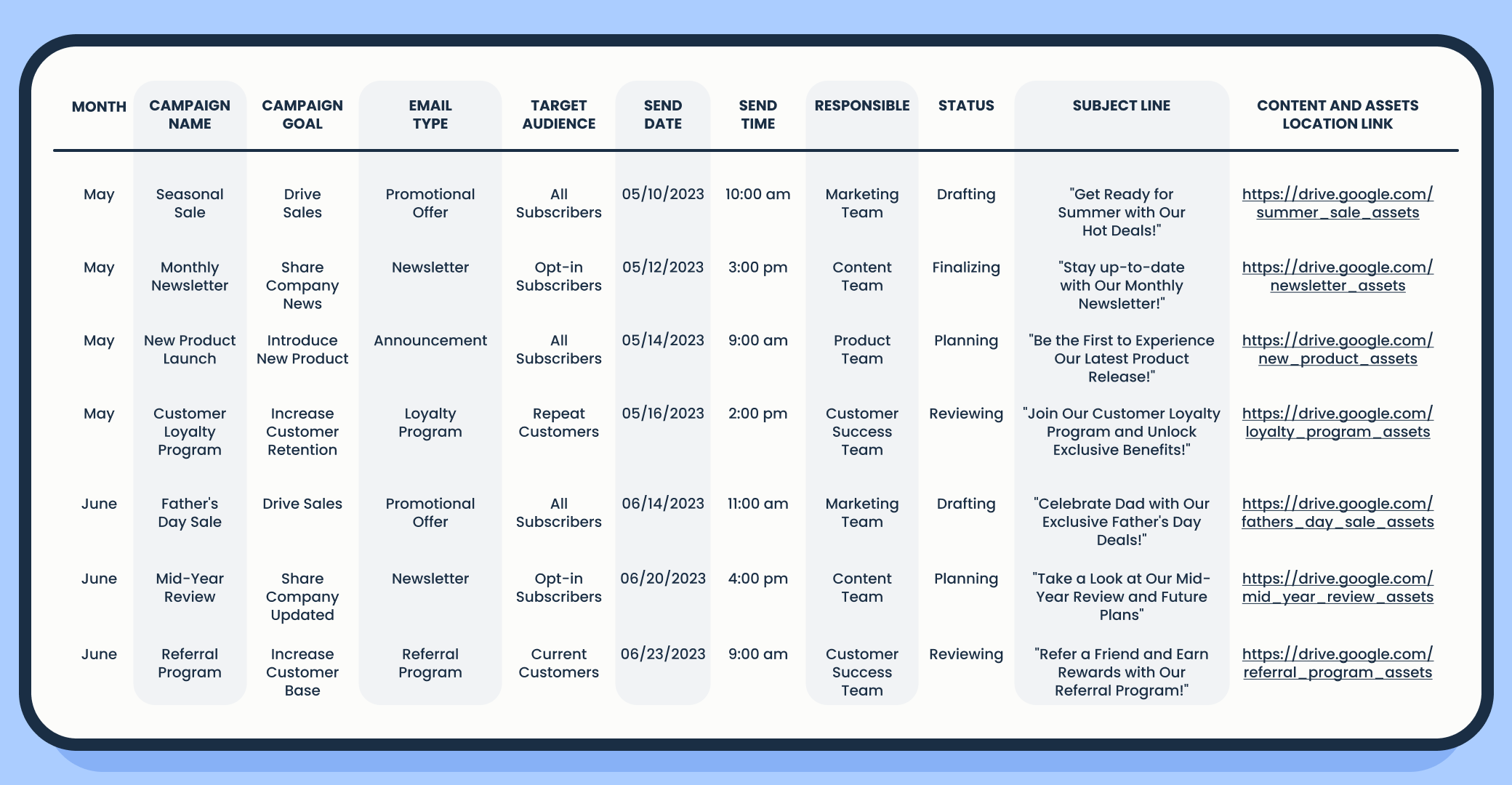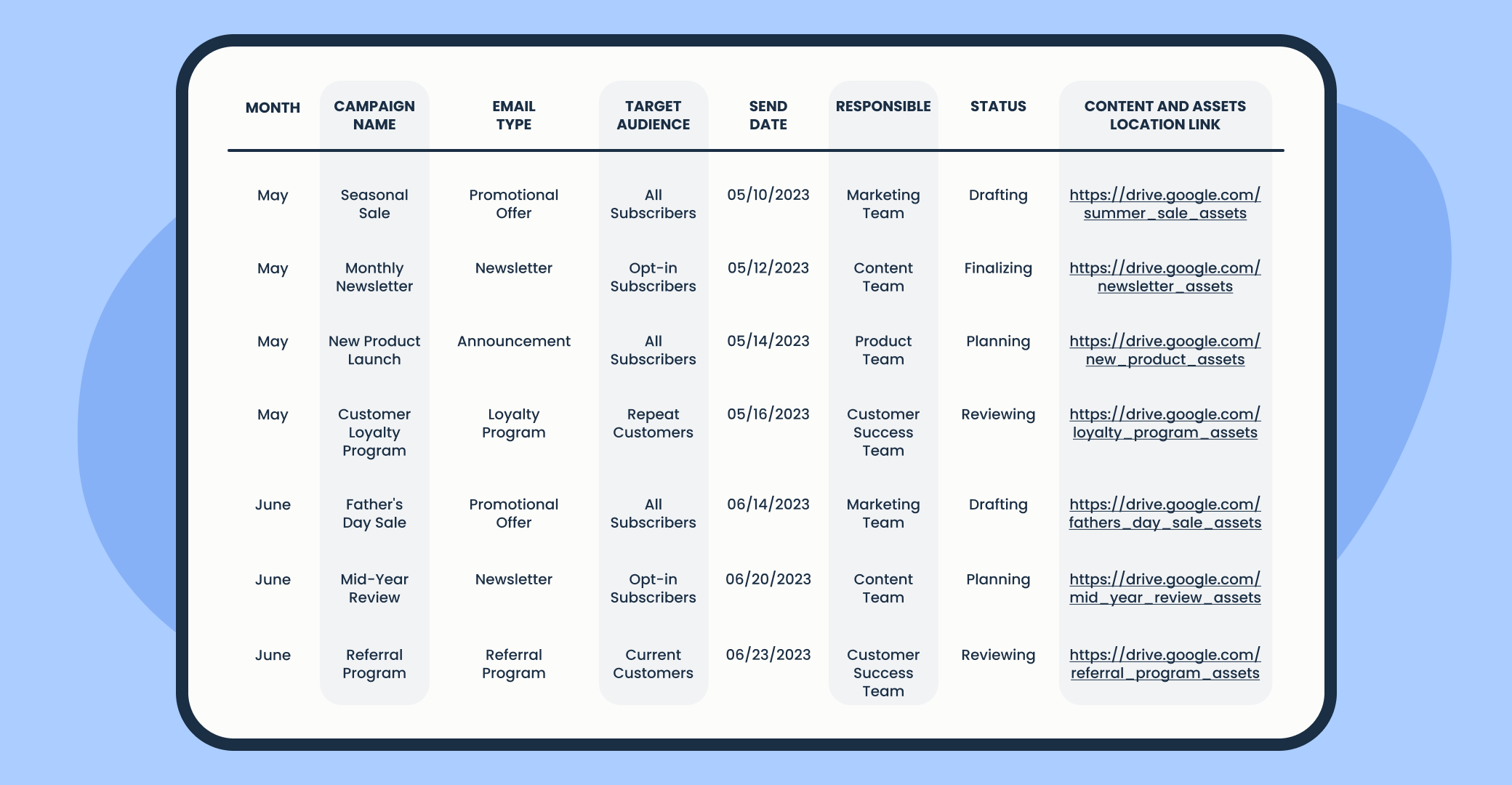
How to create email marketing calendar
22 May, 2023
1
1
0
Contributors
Email marketing is a carefully mapped out and timed endeavor, at least for those who use it to achieve marketing goals in the most optimal way.
That being said, keeping track of all your email marketing campaigns and the tasks related to them can become overwhelming, especially when urgent campaigns unexpectedly creep their way onto your agenda.
So, what is a marketer to do to prevent this feeling of being overwhelmed and having their email marketing strategy properly visualized? The answer is, utilize an email marketing calendar!
In this article, we’ll cover all the ins and outs of email marketing calendars, detailing their creation process, as well as the tools, templates, and best practices.
Let’s dig in, shall we?
What is an email marketing calendar?
An email marketing calendar, in essence, is nothing more than a schedule outlining when marketing messages are to be sent. But, when it comes to most modern email marketing calendars, tasks, details, attachments, and even copies related to the messages are also included.
Think content calendar or editorial calendar, just in this case, used strictly for planning emails.
By using email marketing calendars for your email content marketing strategy, you enable proper planning and resource distribution, the timely delivery of relevant messages, real-time campaign tracking, and more, depending on how advanced/detailed your calendar is.
And who is to use this calendar, you may ask? Well, for starters, your email marketing team. Then, access to the calendar should also be given to other teams that send the occasional email, such as the social media team, product team, content team, and so on.
This way, everyone that needs to be in the loop of who is sending what and when can have a clear overview of your email marketing schedule, thus allowing for proper coordination in your email sending.
Of course, higher-ups who want to see the marketing team’s performance should also be able to access the calendar, but that really depends on how evaluations are done within your company.
The top benefits of email marketing calendars
Beyond the few mentioned top-level benefits, email marketing calendars come with other advantages worth mentioning, which include:
- Never forgetting to send out communication on a holiday or important date
- Being able to easily update your schedule to fit new opportunities
- Having a firmer grasp on your goals
- Allocating responsibilities clearly
- Lowering the chances of a team burnout
- Having enough time for each campaign
- Maintaining consistency in communication
Pretty impressive if you ask us!
How to create an email marketing calendar?
After all this theoretical stuff, we hope you’re ready to get your hands “dirty” and start building your email marketing calendar.
The whole process shouldn’t be too challenging and usually consists of the following steps:
- Pick the software to host the calendar
When it comes to deciding on the software that will host your email marketing calendar, you have the freedom to go a very simple or a very complex route. In other words, you can choose to create the calendar in spreadsheet software like Excel and Google Sheets or some project management or email marketing software with a built-in calendar tool.
We’ll talk more about tools a bit further down in this article!
- Decide what each calendar entry will consist of
For your calendar to be truly helpful, it has to be detailed and informative, meaning each calendar entry will have to include details such as:
- campaign name
- campaign goal
- email type (email newsletter, promotional email, educational email, etc.)
- target audience
- send date
- send time
- person responsible
- status
- subject line
- content and assets location link
You are, of course, free to include more details or exclude some of the listed, all depending on your team’s needs.
- Integrate your calendar with the necessary software
Whether you’ll be able to complete this step or not will depend on the software you pick to host your email marketing calendar, as some software solutions come with more integrations than others.
For example, those of you that create your calendar in Google Sheets can integrate it with:
- AppSheet – a no-code platform for creating mobile and web applications using Google Sheets. With it, you can create a custom calendar view of your data in Google Sheets and add interactive features like drag-and-drop scheduling.
- Calendar Builder – a Google Sheets add-on for creating custom calendars and scheduling events directly within your spreadsheet. In it, you receive a range of customizable templates and the option to import events from Google Calendar or other sources.
- Awesome Table – a Google Sheets add-on for creating dynamic tables, charts, and calendars from your data. Using it, you can create a custom calendar view of your data within Google Sheets and even add filters and a search functionality.
- Provide access to the calendar
We already talked about this earlier in the article, so we won’t go into much more detail now. But as the last step in your calendar-creation process, you’ll simply need to make the calendar accessible to appropriate team members, other teams, partners, and higher-ups.
Email marketing calendar examples and templates
Starting from scratch is the way to go when you’re creating something super original. But let’s face it; calendars are not something you’re going to pour your originality juices into.
Instead, what you’ll want to do is follow some examples or base your calendar on an existing calendar or schedule template.
Below, we’ll show two email marketing calendar examples – a detailed and a simplified version – as well as link to some downloadable templates popular in the email marketing community.
Email marketing calendar examples
Our first example is a calendar intended for digital marketing teams who like to have quite precise plans and thus includes details for everything from the campaign name and goal to the email subject line.

Our second email calendar example, on the other hand, is somewhat simplified and can be used by teams who don’t want detailed plans but rather ones that are general yet understandable.

For more templates and tips click here and continue reading the Mailtrap blog post.
